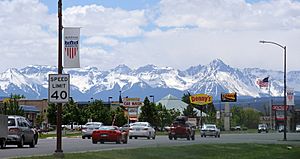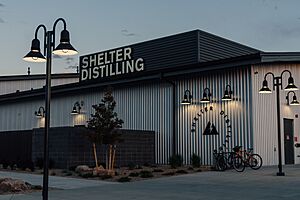Montrose, Colorado facts for kids
Quick facts for kids
Montrose, Colorado
|
||
|---|---|---|

South Townsend Avenue in Montrose
|
||
|
||
| Motto(s):
"Quality of Life Is Our Commitment "
"Stay here, play everywhere" |
||

Location in Montrose County, Colorado
|
||
| Country | ||
| State | ||
| County | Montrose County | |
| City | Montrose | |
| Incorporated | May 1, 1882 | |
| Government | ||
| • Type | Home rule municipality | |
| Area | ||
| • Total | 18.48 sq mi (47.9 km2) | |
| • Land | 18.48 sq mi (47.9 km2) | |
| • Water | 0.0 sq mi (0 km2) | |
| Elevation | 5,807 ft (1,770 m) | |
| Population
(2020)
|
||
| • Total | 20,291 | |
| • Density | 1,098.2/sq mi (424.0/km2) | |
| Time zone | UTC−7 (MST) | |
| • Summer (DST) | UTC−6 (MDT) | |
| ZIP codes |
81401, 81402 (PO Box), 81403
|
|
| Area code(s) | 970 | |
| FIPS code | 08-51745 | |
| GNIS feature ID | 203328 | |
Montrose is a city in Colorado, United States. It is the main city and county seat of Montrose County, Colorado. In 2020, about 20,291 people lived here. The city covers an area of 18.5 square miles. The main road through Montrose is U.S. Highway 50.
Montrose is located in western Colorado. It sits in the Uncompahgre Valley. The city is an important center for jobs and transportation in the area. It is the second-largest city in western Colorado, after Grand Junction.
Contents
History of Montrose
Montrose became an official city on May 2, 1882. It was named after the Marquis of Montrose. This name came from a novel by Sir Walter Scott called A Legend of Montrose. Two people, Oliver D. "Pappy" Loutzenhizer and Joseph Selig, chose the name.
Later in 1882, the Denver & Rio Grande railroad reached Montrose. This made the town a key shipping center for the region. A special train line also went to the San Juan Mountains to the south. These mountains were rich in minerals.
In 1909, the U.S. government finished building the Gunnison Tunnel. This tunnel is east of Montrose. It brought water from the Gunnison River in the Black Canyon. This water helped irrigate the Uncompahgre Valley. This made Montrose an important farming area. The Uncompahgre Project is one of the oldest water projects by the U.S. Bureau of Reclamation.
Montrose Geography and Climate
Montrose is located at the south end of the Uncompahgre Valley. The city is built along the Uncompahgre River. This river flows north and joins the Colorado River about 60 miles away.
The city is surrounded by different natural features:
- To the north: The wide Uncompahgre Valley and the Grand Mesa.
- To the east: The Black Canyon of the Gunnison National Park.
- To the south: The San Juan Mountains.
- To the west: The Uncompahgre Plateau.
The valley is naturally dry. Farming is possible only because of water from the Gunnison Tunnel and Ridgway Reservoir.
Montrose Climate Overview
Montrose has a semi-arid continental climate. This means it is usually dry with hot summers and cold winters. The city is on high grasslands in the Uncompahgre Valley. Snow falls in winter but usually does not stay long. This is because of the high elevation and lots of sunshine.
| Climate data for Montrose, Colorado, 1991–2020 normals, extremes 1895–present | |||||||||||||
|---|---|---|---|---|---|---|---|---|---|---|---|---|---|
| Month | Jan | Feb | Mar | Apr | May | Jun | Jul | Aug | Sep | Oct | Nov | Dec | Year |
| Record high °F (°C) | 67 (19) |
72 (22) |
83 (28) |
89 (32) |
93 (34) |
102 (39) |
103 (39) |
106 (41) |
97 (36) |
88 (31) |
77 (25) |
68 (20) |
106 (41) |
| Mean maximum °F (°C) | 52.5 (11.4) |
59.9 (15.5) |
70.5 (21.4) |
78.1 (25.6) |
86.1 (30.1) |
93.9 (34.4) |
96.8 (36.0) |
93.2 (34.0) |
88.9 (31.6) |
80.1 (26.7) |
66.6 (19.2) |
54.9 (12.7) |
97.1 (36.2) |
| Mean daily maximum °F (°C) | 40.2 (4.6) |
46.4 (8.0) |
56.8 (13.8) |
64.1 (17.8) |
73.9 (23.3) |
85.5 (29.7) |
90.2 (32.3) |
87.1 (30.6) |
79.4 (26.3) |
66.5 (19.2) |
52.2 (11.2) |
40.6 (4.8) |
65.2 (18.5) |
| Daily mean °F (°C) | 28.8 (−1.8) |
34.7 (1.5) |
43.5 (6.4) |
50.3 (10.2) |
59.4 (15.2) |
69.4 (20.8) |
74.7 (23.7) |
72.3 (22.4) |
64.2 (17.9) |
51.9 (11.1) |
39.7 (4.3) |
29.2 (−1.6) |
51.5 (10.8) |
| Mean daily minimum °F (°C) | 17.5 (−8.1) |
23.0 (−5.0) |
30.2 (−1.0) |
36.6 (2.6) |
45.0 (7.2) |
53.3 (11.8) |
59.2 (15.1) |
57.5 (14.2) |
49.0 (9.4) |
37.3 (2.9) |
27.2 (−2.7) |
17.7 (−7.9) |
37.8 (3.2) |
| Mean minimum °F (°C) | 3.1 (−16.1) |
7.4 (−13.7) |
15.5 (−9.2) |
23.2 (−4.9) |
31.8 (−0.1) |
40.9 (4.9) |
49.8 (9.9) |
48.2 (9.0) |
35.7 (2.1) |
22.8 (−5.1) |
11.3 (−11.5) |
2.2 (−16.6) |
−1.3 (−18.5) |
| Record low °F (°C) | −25 (−32) |
−27 (−33) |
−5 (−21) |
2 (−17) |
17 (−8) |
27 (−3) |
35 (2) |
37 (3) |
21 (−6) |
5 (−15) |
−8 (−22) |
−21 (−29) |
−27 (−33) |
| Average precipitation inches (mm) | 0.51 (13) |
0.47 (12) |
0.68 (17) |
0.77 (20) |
0.82 (21) |
0.50 (13) |
0.90 (23) |
1.12 (28) |
1.24 (31) |
1.03 (26) |
0.65 (17) |
0.64 (16) |
9.33 (237) |
| Average snowfall inches (cm) | 4.7 (12) |
3.9 (9.9) |
2.2 (5.6) |
0.6 (1.5) |
0.0 (0.0) |
0.0 (0.0) |
0.0 (0.0) |
0.0 (0.0) |
0.0 (0.0) |
0.5 (1.3) |
2.7 (6.9) |
6.9 (18) |
21.5 (55.2) |
| Average extreme snow depth inches (cm) | 3.5 (8.9) |
3.3 (8.4) |
1.7 (4.3) |
0.6 (1.5) |
0.0 (0.0) |
0.0 (0.0) |
0.0 (0.0) |
0.0 (0.0) |
0.0 (0.0) |
0.4 (1.0) |
1.6 (4.1) |
3.4 (8.6) |
4.8 (12) |
| Average precipitation days (≥ 0.01 in) | 4.6 | 4.6 | 5.4 | 5.8 | 5.6 | 3.3 | 6.3 | 7.9 | 6.5 | 5.7 | 4.4 | 5.0 | 65.1 |
| Average snowy days (≥ 0.1 in) | 2.8 | 2.4 | 1.4 | 0.5 | 0.0 | 0.0 | 0.0 | 0.0 | 0.0 | 0.3 | 1.3 | 3.6 | 12.3 |
| Source 1: NOAA | |||||||||||||
| Source 2: National Weather Service | |||||||||||||
Montrose Population Facts
| Historical population | |||
|---|---|---|---|
| Census | Pop. | %± | |
| 1890 | 1,330 | — | |
| 1900 | 1,217 | −8.5% | |
| 1910 | 3,254 | 167.4% | |
| 1920 | 3,581 | 10.0% | |
| 1930 | 3,566 | −0.4% | |
| 1940 | 4,764 | 33.6% | |
| 1950 | 4,964 | 4.2% | |
| 1960 | 5,044 | 1.6% | |
| 1970 | 6,496 | 28.8% | |
| 1980 | 8,722 | 34.3% | |
| 1990 | 8,854 | 1.5% | |
| 2000 | 12,344 | 39.4% | |
| 2010 | 19,132 | 55.0% | |
| 2020 | 20,291 | 6.1% | |
| U.S. Decennial Census 2020 | |||
In 2020, Montrose had 20,291 people living in 8,175 households. The average age of people in Montrose was 45.2 years old. The average time people spent commuting to work was about 15.4 minutes. This is much shorter than the average commute in Colorado.
About 21% of the people in Montrose were under 18 years old. About 25.3% were 65 years or older. For every 100 females, there were about 86 males. Most people in Montrose own their homes. The average rent was $936 per month. This is lower than the average rent in Colorado.
Montrose Economy and Jobs
Montrose is known for making outdoor products. This is because it is affordable and close to many outdoor activities. Several companies that make fly-fishing gear are based here. These include Ross Reels, Abel, and Airflo.
Scott Fly Rods moved to Montrose in 1993. Gordon Composites, which makes materials for bow-hunting, is also in Montrose. Secret Creek, known for making yurts and tents, is another local business.
In 2017, the city approved $10 million for public improvements. This was for the Colorado Outdoors development. The city also received a $2 million grant for a new trail system. This grant was the largest ever given to Montrose. The new trails connect to the Montrose Recreation Center.
In 2020, Montrose started a big river restoration project. This project is along the Uncompahgre River. It received a $785,000 grant for this work. In 2024, new businesses like Shelter Distilling and Toasty restaurant opened. They received help from the city.
Parks and Recreation in Montrose
Montrose has many places for fun and outdoor activities.
- The [Montrose Water Sports Park] is a great place for water activities.
- There is a large community recreation center. It has an indoor track for walking or jogging.
- The city has over 38 public parks.
Montrose is also very friendly for bicycles. The League of American Bicyclists has called it a Bicycle Friendly Community. There are also three 18-hole golf courses in the city.
Education in Montrose
Montrose is served by the Montrose County School District RE-1J. This district has more than 6,000 students. They attend 15 schools in Montrose and Olathe.
For higher education, Montrose has a campus of Colorado Mesa University. CMU Montrose offers 14 different study programs. It also has general education courses. In fall 2023, nearly 300 students attended CMU Montrose. Montrose also has a branch of Technical College of the Rockies. This college offers training for different jobs.
Transportation in Montrose
The Montrose Regional Airport serves the area. It has flights to Denver. Many people use this airport to get to the Telluride Ski Area. Montrose has a local bus service called All Points Transit. It runs on weekdays. Montrose is also part of Colorado's Bustang intercity bus network. Three bus lines serve the town.
Major Roads in Montrose
- US 50 connects Montrose to Grand Junction, Gunnison, and Pueblo.
- US 550 ends in Montrose. It connects the city to Silverton, Ouray, and Durango.
Famous People from Montrose
- Anna Lee Aldred: She was the first American woman to get a jockey license. She was born in Montrose.
- Pat Valenzuela: This horse jockey won the Kentucky Derby and Preakness. He was also born in Montrose.
- Myron "Mike" Ullman: He was the former CEO of JCPenney stores. He also used to be the chairman of Starbucks.
- Dalton Trumbo: He was an American screenwriter and novelist. He wrote famous films like Roman Holiday and Spartacus. He was born in Montrose.
See also
 In Spanish: Montrose (Colorado) para niños
In Spanish: Montrose (Colorado) para niños





